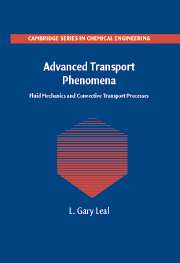Book contents
- Frontmatter
- Contents
- Preface
- Acknowledgments
- 1 A Preview
- 2 Basic Principles
- 3 Unidirectional and One-Dimensional Flow and Heat Transfer Problems
- 4 An Introduction to Asymptotic Approximations
- 5 The Thin-Gap Approximation – Lubrication Problems
- 6 The Thin-Gap Approximation – Films with a Free Surface
- 7 Creeping Flow – Two-Dimensional and Axisymmetric Problems
- 8 Creeping Flow – Three-Dimensional Problems
- 9 Convection Effects in Low-Reynolds-Number Flows
- 10 Laminar Boundary-Layer Theory
- 11 Heat and Mass Transfer at Large Reynolds Number
- 12 Hydrodynamic Stability
- Appendix A Governing Equations and Vector Operations in Cartesian, Cylindrical, and Spherical Coordinate Systems
- Appendix B Cartesian Component Notation
- Index
12 - Hydrodynamic Stability
Published online by Cambridge University Press: 05 June 2012
- Frontmatter
- Contents
- Preface
- Acknowledgments
- 1 A Preview
- 2 Basic Principles
- 3 Unidirectional and One-Dimensional Flow and Heat Transfer Problems
- 4 An Introduction to Asymptotic Approximations
- 5 The Thin-Gap Approximation – Lubrication Problems
- 6 The Thin-Gap Approximation – Films with a Free Surface
- 7 Creeping Flow – Two-Dimensional and Axisymmetric Problems
- 8 Creeping Flow – Three-Dimensional Problems
- 9 Convection Effects in Low-Reynolds-Number Flows
- 10 Laminar Boundary-Layer Theory
- 11 Heat and Mass Transfer at Large Reynolds Number
- 12 Hydrodynamic Stability
- Appendix A Governing Equations and Vector Operations in Cartesian, Cylindrical, and Spherical Coordinate Systems
- Appendix B Cartesian Component Notation
- Index
Summary
The subject of hydrodynamic stability theory is concerned with the response of a fluid system to random disturbances. The word “hydrodynamic” is used in two ways here. First, we may be concerned with a stationary system in which flow is the result of an instability. An example is a stationary layer of fluid that is heated from below. When the rate of heating reaches a critical point, there is a spontaneous transition in which the layer begins to undergo a steady convection motion. The role of hydrodynamic stability theory for this type of problem is to predict the conditions when this transition occurs. The second class of problems is concerned with the possible transition of one flow to a second, more complicated flow, caused by perturbations to the initial flow field. In the case of pressure-driven flow between two plane boundaries (Chap. 3), experimental observation shows that there is a critical flow rate beyond which the steady laminar flow that we studied in Chap. 3 undergoes a transition that ultimately leads to a turbulent velocity field. Hydrodynamic stability theory is then concerned with determining the critical conditions for this transition.
For both types of problem, we can view the mathematical problem as one of determining the consequence of adding an initial perturbation in the velocity, pressure, temperature, or solute concentration fields to a basic unperturbed state. If the perturbation grows in time, the original unperturbed state is said to be unstable.
- Type
- Chapter
- Information
- Advanced Transport PhenomenaFluid Mechanics and Convective Transport Processes, pp. 800 - 890Publisher: Cambridge University PressPrint publication year: 2007



